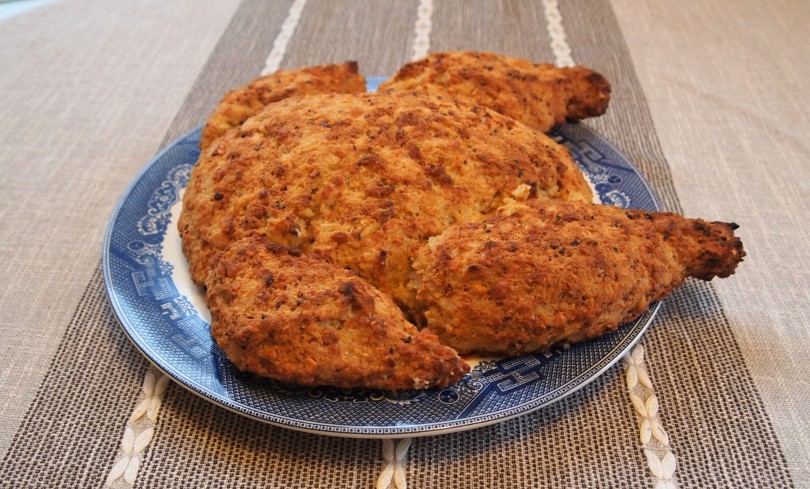Vegetarianism has a long history in the United States, although the word “vegetarian” was not in common usage until around the 1850s. By the 1880s, vegetarian meat substitutes that were meant to mimic the look and taste of meat helped bring vegetarian foods to a wider audience, and vegetarianism was widely promoted as part of a healthy lifestyle.
Although Sarah Tyson Rorer was not herself a vegetarian, she capitalized on the popularity of meat substitutes for her 1909 cookbook Mrs. Rorer’s Vegetable Cookery and Meat Substitutes. This rather elaborate recipe attempts to mimic both the taste and appearance of a turkey.

Mock Turkey
- 2 cups bread crumbs
- 2 cups water
- 2 cups mixed nuts, finely chopped (1 cup peanuts and 1 cup pine nuts)
- 2 cups cooked rice
- 6 hard-boiled eggs, finely chopped
- 3 raw eggs, slightly beaten.
- 1 tbsp grated onion
- 1/2 tbsp salt (reduced from original recipe)
- pepper
- melted butter
- dry macaroni (optional)
- Put the breadcrumbs and water in a saucepan and heat over medium heat for a few minutes.
- Add the chopped hard-boiled eggs and mix together.
- Move the mixture to a bowl and mix in the nuts, rice, onion, and salt and pepper.
- Pour in the raw eggs and mix well.
- Form the mixture into the shape of a turkey, using smaller lumps of the mixture for the wings and legs. Press the legs and wings to the side of the turkey. Optionally, use dry macaroni to represent the bones in the turkey’s legs; I didn’t try this so I’m not sure how it would look.
- Brush the “turkey” all over with butter.
- Bake at 350 degrees for about an hour or longer – I took mine out after an hour, but it probably could have gone a little longer. I also turned the broiler on for about 30 seconds to give the “turkey” some color.



Tasting notes:
I fully expected this recipe to be awful, but surprisingly, it was not nearly as bad as I thought it would be. That being said, I would still not recommend replacing the turkey in your holiday dinner just yet. While it was surprisingly edible, and the flavor was decent, the texture left something to be desired and would definitely not be mistaken for meat. Even after an hour of baking, the “turkey” still seemed too wet on the inside; I’m not sure if baking it longer would have fixed that textural issue. Also, although I chopped all the ingredients very finely, it was still possible to distinguish individual bits of ingredients in the “turkey,” which gave it an odd texture. I am curious what would happen if the ingredients were all run through a food processor together – it could make the texture smoother, or it could just turn into a mush. Either way, I have no plans to make this again to find out.
There are definitely much better meat substitutes available today; but even so, I was impressed that Mrs. Rorer’s recipe turned out to be at least relatively edible. For vegetarians at the time, it must have seemed amazing to be able to recreate a whole turkey from just bread, rice, eggs, and nuts.

References:
Rorer, S.T. (1909). Mrs. Rorer’s vegetable cookery and meat substitutes. Philadelphia: Arnold & Company. https://books.google.com/books?id=vu0qAAAAYAAJ&printsec=frontcover&source=gbs_ge_summary_r&cad=0#v=onepage&q&f=false
Shprintzen, A. (2013). The vegetarian crusade : the rise of an American reform movement, 1817-1921. University of North Carolina Press.


Very interesting post. Thanks for sharing it.
LikeLike